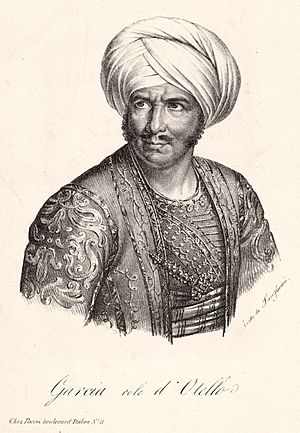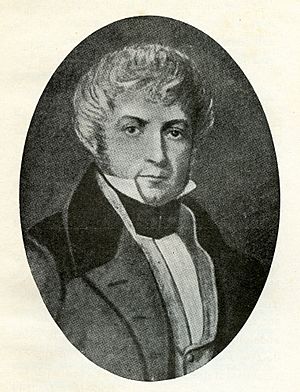Manuel García (tenor) facts for kids
Manuel del Pópulo Vicente Rodriguez García (born January 21, 1775 – died June 10, 1832) was a famous Spanish opera singer (a type of singer called a tenor), a composer (someone who writes music), an impresario (someone who organizes shows), and a singing teacher. He was also known as Manuel García the Senior to tell him apart from his son.
Biography
Manuel García was born in Seville, Spain. He started his career as a tenor singer in cities like Madrid and Cadiz. In 1808, he moved to Paris, France. By then, he was already writing his own light operas. He also lived in Naples, Italy, where he sang in operas by the famous composer Gioachino Rossini. He even performed in the very first shows of Rossini's operas Elisabetta, regina d'Inghilterra and The Barber of Seville. In The Barber of Seville, he played the role of Count Almaviva.
García traveled a lot, performing in London, England, and Paris. He sang in popular operas like The Barber of Seville, Otello, and Don Giovanni. He also presented his own new French-style operas in Paris.
His family was full of talented musicians! His older daughter, Maria Malibran, became a very famous mezzo-soprano singer. His second daughter, Pauline Viardot, was also a brilliant singer and musician. His son, Manuel Patricio Rodríguez García, became a world-famous singing teacher, known for his methods of teaching voice.
In 1825, Manuel García and his opera company traveled to New York City. Four of the eight members of his company were from his own family! They were invited by Dominick Lynch, Jr., who wanted to bring Italian opera to New York. They put on the first Italian opera performances in New York, performing about 80 shows. The García family took all the main parts in The Barber of Seville. Manuel García sang as Almaviva, his second wife Joaquina Sitchez (also called "la Briones") was Berta, his son Manuel Jr. was Figaro, and his daughter Maria was Rosina. His younger daughter Pauline was still too young to perform. They also performed Mozart's opera Don Giovanni, with Manuel García singing the main role.
The company also performed in Mexico. Manuel García later shared a story about being robbed of all his money by bandits while traveling between Mexico and Vera Cruz.
García had planned to stay in Mexico, but because of political problems, he had to return to Paris in 1829. People in Paris were very happy to see him back. However, his voice was getting tired from age and all the performing. He kept writing music, but he soon focused on teaching, which he was very good at. He performed on stage for the last time in August 1831. He passed away on June 10, 1832, and was buried in Père Lachaise Cemetery.
Manuel García's influence was huge, reaching three continents. His children continued his legacy, carrying his musical ideas into the 20th century.
His Singing Style

Even though Manuel García was Spanish, he became a perfect example of an Italian-style tenor singer in the early 1800s. He learned a lot about singing when he went to Italy in 1812 and met a respected teacher named Giovanni Ansani. Ansani taught him how to make his voice strong and clear, which helped him sing Rossini's challenging music.
García had a very wide vocal range. His voice was deep for a tenor, sometimes sounding like a baritone (a lower male voice). He could even sing some baritone parts! He was known for being able to sing very high notes, even a "C from the chest," which was very impressive for his time.
He also mastered a singing technique called falsetto, where a male singer can produce very high notes that sound like a female voice. He was so good at it that in one of his own short operas, El poeta calculista, he sang a duet with himself, performing both the tenor and the soprano (highest female voice) parts!
Manuel García had a strong personality, sometimes even a bit wild. He brought this energy to the stage, making his performances in operas like Otello and Don Giovanni unforgettable. But he could also control his powerful style to play elegant and proud characters, like Count Almaviva in Mozart's opera.
Salon Operas
In his later years, Manuel García wrote five short operas, often called "salon operas." He wrote these to show off the talents of his students. Two of these operas, L’isola disabitata and Un avvertimento ai gelosi, have been performed again in modern times. L’sola disabitata was first performed in the United States in 2005 and then in Spain in 2010. Un avvertimento ai gelosi was performed in Spain in 2016 and in North America in 2016 and 2017.
Selected Works
Manuel García wrote many musical pieces, including operas and shorter works called tonadillas. Here are some of his works that were performed:
- La maja y el majo (a short musical play, Madrid, 1798)
- Il califfo di Bagdad (a funny opera, Naples, 1813)
- Talla e Dallaton, o sia La donzella di Raab (a serious opera, Naples, 1814)
- Il fazzoletto (a funny opera, Paris, 1820)
- La mort du Tasse (a tragic opera, Paris, 1821)
- Florestan, ou Le conseil des dix (an opera, Paris, 1822)
- L'amante astuto (a comic opera, New York, 1825)
- La figlia del aria (a semi-tragic opera, New York, 1826)
- El Abufar, ossia La famiglia araba (Mexico City, 1827)
He also wrote other works that were not performed in public, or only performed for small groups, such as:
- Un avvertimento ai gelosi
- Le cinesi
- L'isola disabitata
- Don Chisciotte (a funny opera)
Family Tree
- Manuel García (1775–1832), singer, composer, impresario; married Joaquina Sitches (1780–1864)
- Manuel García Junior (1805–1906), singer, composer, singing teacher; married Cécile Maria "Eugénie" Mayer (1814–1880)
- Manuel García (1836–1885)
- Gustave García (1837–1925), baritone and singing teacher; married Emily Matilda Ann Martorell (1835–?)
- Alberto García (1875–1946), baritone
- Eugenie Harouel (1840–1924)
- Marie Crèpet (1842–1867)
- Maria Malibran (1808–1836), singer; married Francois Eugene Malibran (1781–1836) (no children); married Charles Auguste de Bériot (1802–1870), composer, violinist
- Charles-Wilfrid de Bériot (1833–1914), pianist, composer, professor at the École Niedermeyer
- Pauline Viardot (1821–1910), singer, composer; married Louis Viardot (1800–1883)
- Louise Héritte-Viardot (1841–1918), composer, pianist, singer
- Paul Viardot (1857–1941)
- Marianne Viardot (1854–1919), painter, briefly engaged to Gabriel Fauré; married Alphonse Duvernoy
- Claudie Viardot (1852–1914); married Georges Chamerot; had issue
- Manuel García Junior (1805–1906), singer, composer, singing teacher; married Cécile Maria "Eugénie" Mayer (1814–1880)
See also
 In Spanish: Manuel del Pópulo Vicente García para niños
In Spanish: Manuel del Pópulo Vicente García para niños


